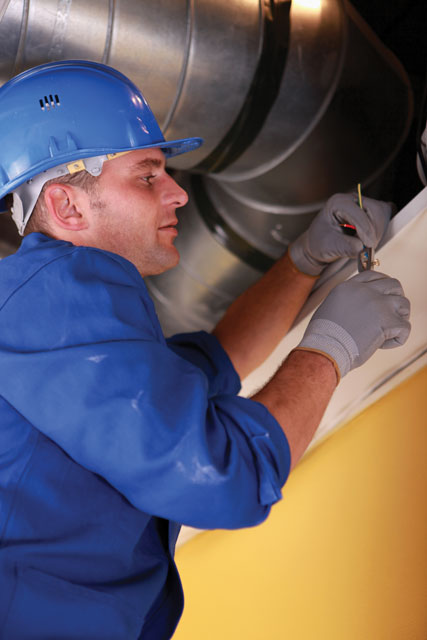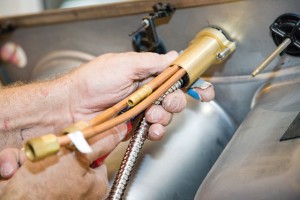 If you have ever caught the “Restaurant Makeover” program on television, zoom into the kitchen and the hosts are usually shocked at the dilapidated state of affairs – from hygiene, to storage, subsequently to poor management and maintenance of equipments. Maintenance is a big chunk in determining efficiency and longevity of machineries but many restaurateurs overlook its importance because, well, if it is not broken, why the need to fix it? In a kitchen setting, you do not wait till it is broken. Regular checking and maintenance is necessary to avoid sudden breakdowns that require repair costs or purchasing a new one. Also, when any machine breaks down, it is bound to affect the service side and that eventually eats into your profit margins as well. Print it out; stick it up on the walls of the kitchen as a constant reminder on reaping the benefits of a well-serviced piece of equipment.
If you have ever caught the “Restaurant Makeover” program on television, zoom into the kitchen and the hosts are usually shocked at the dilapidated state of affairs – from hygiene, to storage, subsequently to poor management and maintenance of equipments. Maintenance is a big chunk in determining efficiency and longevity of machineries but many restaurateurs overlook its importance because, well, if it is not broken, why the need to fix it? In a kitchen setting, you do not wait till it is broken. Regular checking and maintenance is necessary to avoid sudden breakdowns that require repair costs or purchasing a new one. Also, when any machine breaks down, it is bound to affect the service side and that eventually eats into your profit margins as well. Print it out; stick it up on the walls of the kitchen as a constant reminder on reaping the benefits of a well-serviced piece of equipment.
1. Daily or intermittent showers
Flush out any dirt, grime or food scraps that can build up in the equipment, particularly in small crevices which in time will cause damage to the machine’s components. Daily cleaning requirements vary from equipments so it is important to read the instruction manual right at the start so that you can make notes on the intervals of cleaning every equipment needs. It could be weekly, monthly or semi-annually. Remember that health officers consider the cleanliness of equipments a factor in their overall grading.
2. Schedule regular inspections
Make this a natural follow-up when thorough cleaning is being scheduled. Check for tear and leaks, utility connections and any moving parts. This allows you to find and address small maintenance issues at an early stage to prevent big repair expenditure in the future.
3. Let the experts handle it
Along the same vein, if you find anything irregular, you may be tempted to fix-it-yourself to save some money. However, it is not exactly recommended unless you have very tip-top knowledge on the equipment. Many may make the mistake of a DIY only to find that it did not work and having to contact the manufacturer, which runs the risk of the warranty being null and void. Having said that, some things you might be able to do on your own and is stated in the instruction manual. If the warranty has run its course, save yourself the frustration and hassle by calling the professional to check and repair the faulty area. Do replace broken or problematic parts immediately as you always want to keep the workplace as low-risk as possible.

4. Read the papers
This refers to the owner’s manual – the most comprehensive piece of information about a machine. A competent and recognised manufacturer will ensure that the manual is complete with step-by-step instructions on servicing and maintaining of its equipment. While general tips can be found on the web, it is always better to get your information from the maker. Another piece of paper that you should take note is the warranty card as expensive equipments usually come with manufacturer’s warranty that might include free par ts, labour, or ser vice for a certain amount of time. You might want to fill the card up and return to manufacturer immediately after receiving the machine as you do not want to miss out on the benefits.

5. Always adhere to care instructions
This refers to cleaning agents. Many of the material used to make equipments likely require special cleaning compounds, not general ones. It is an aspect often taken for granted as the effects may not set in immediately but there is reason specific compounds are listed in the manual. Using the wrong combination of chemicals can pose a danger to employees as well as damage the equipment. And if you notice, most commercial kitchens use equipments made out of stainless steel. Yet, stainless steel can become tarnished, corroded or stained without proper care thus always make sure that mild detergents and soft cloths are used.

6. Educating for effective equipments
One glaring lack in many restaurant operations is education – whether in service etiquette, understanding of the restaurant and even on equipment use. It was found that a majority of equipment malfunction is a result of misuse and abuse. Before you allow the employees to work, take some time to watch that they have successfully learned how to use, clean and maintain the equipment because warranties do not cover damage from misuse

7. Journal of equipment maintenance
Being caught up in the frenzy of service, the crew may make maintenance something convenient to leave till the next day…and the next day…until the machine really breaks down. Keep a written diary, noting when the maintenance schedule is. Also jot down any issues you want to bring up to the manufacturer. To help restaurateurs keep tabs on their equipment, there are even online software applications that allow them to customise and schedule maintenance intervals, plus they come with alerts and reminders, ideal for the busy manager / owner / operator.We cannot stress enough the importance of equipments because a kitchen does not come alive without these machines. They have made the lives of chefs so much easier and more productive, allowing them to further satisfy the palate of eager diners. Thus, we bid you to put equipment maintenance high on your to-do list?
http://500gallons.com/the-impor tance-of-restaurant-equipment-maintenance










